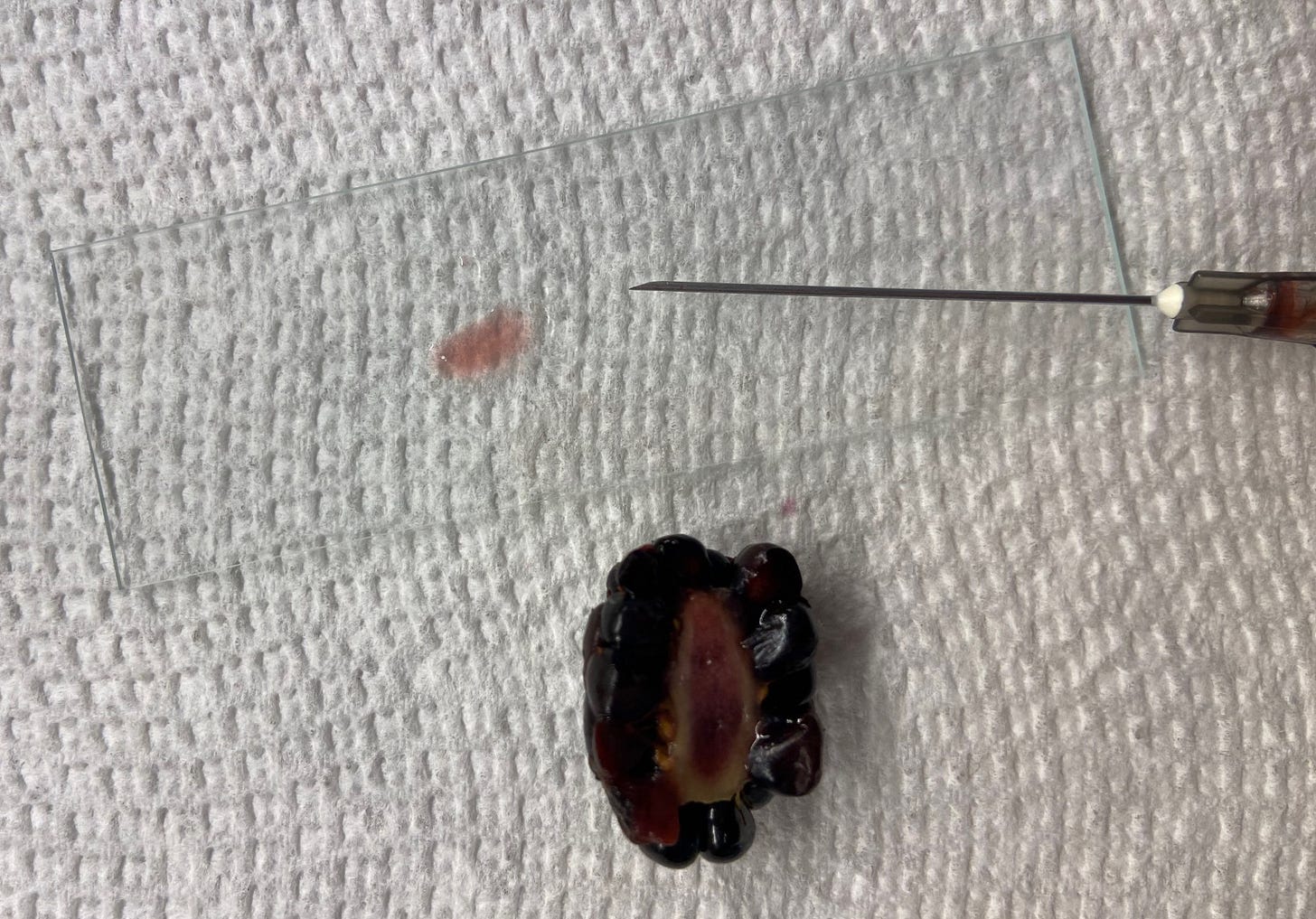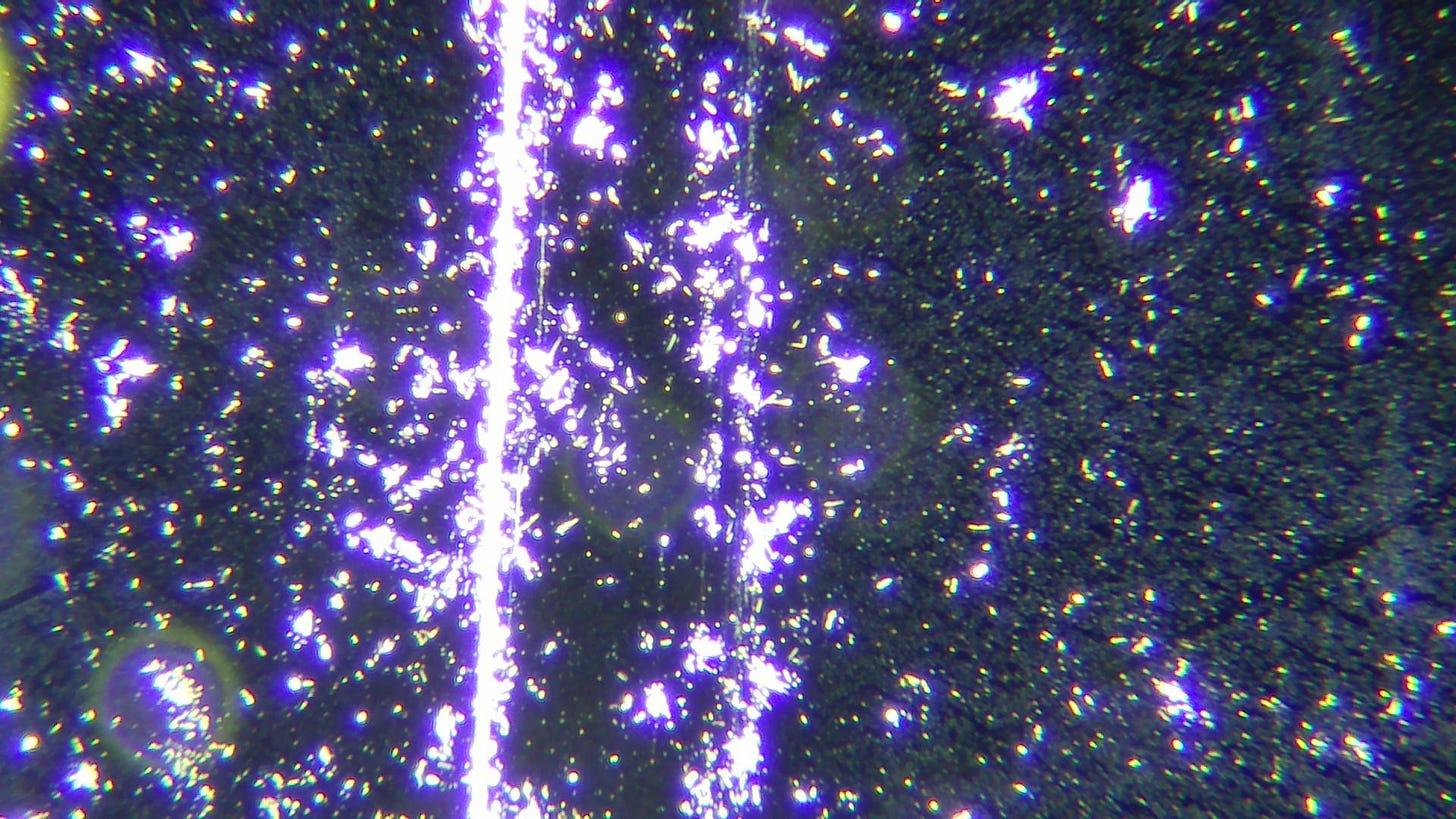Self-Assembling Construction Sites in Fruit and Vegetables and a Chicken
Under the Dark Field Microscope
After posting self-assembling structures in a steak I had defrosted last week, the question came up whether vegetables and fruit could be affected as well. This week I prepared slides from organic grapefruit, lemon, grape, cucumber, blackberry as well as non organic watermelon and tomatoes.
I found construction sites at 1600 magnification in Grape, Lemon, Blackberry, Grapefruit and possibly in Watermelon where I only found round discs. I first thought these were air bubbles which usually pop and go away when applying pressure to the coverslip on the slide. Only these discs didn’t pop and stayed put. I can’t determine if these are artificial constructions or not. I hope to get some input from others checking fruit and vegetables under a dark field microscope so we can compare the images.
The chicken had no active construction sites but several very straight parallel lines that I can’t attribute to anything else.
Here is juice from a grape at 1600 magnification showing a round structure with dots in various colors moving around and within it:
Here is a photo of a drop of lemon juice showing a fiber with no cellular structure:
And a video at 1600 magnification shows a round construction with dots moving about:
Here is a Blackberry at 1600 magnification again showing a round construction site with moving dots:
Here is a grapefruit drop showing the same:
The Watermelon had these round discs:
The tomato showed a lot of activity, but I don’t really see them as dots doing organized construction:
I also examined the drippings of a defrosted chicken thigh: The first image is at 800 magnification, the second at 1600.
The cucumber was grown in a greenhouse, so it was not exposed to rain (chemtrail contents). It didn’t show any dots. The bubble is an air bubble as it popped.
This means that organic fruit and vegetables are just as affected as non-organic ones, but that greenhouse grown vegetables seem not to be affected. This is of course only one example of a greenhouse cucumber and confirmation is necessary to come to a firm conclusion.









I've been doing soil and compost microscopy since 2011 in a RegenAg/compost tea context. I have an Olympus EHT phase contrast bench quality scope from the 1970's. I don't see anything that looks remarkable tbh.
Technically there's no regular scope that can go above 1000x, 1600x is 1000x with digital zoom, not the same thing as 1600x, i.e. you can't see smaller things at 1600x than you can see at 1000x, you just blow up what you can see into a bigger image.
Mostly I see bacteria feeding, you can't tell exactly what substance they're feeding on with a light microscope, they're not 'assembling' anything. If it were a soil sample I'd say the round things they're buzzing around are protists. Seems a lot of bacteria for a food sample, and I wouldn't expect to see protists in a food sample, but that's an assumption on my part I'm not a food analyst. How old are the samples and is there any chance of contamination? Looks like your cucumber was a lot fresher that the other samples.
If you think it's an 'assembly' leave the slide under the scope with the light off (to slow drying of the slide) and take another pic of it every hour, or keep recording until the slide dries out, show before and after 'assembly' i.e. show a changed state.
The glowing discs are microbubbles, if you understand how phase contrast works, by defraction, the bubbles throw the direction of the split light source off acting like a mini lens, so you lose the darkfield around them, I'm 100% sure on that one.
The fiber looks like microplastic, often seen in compost samples, most likely source is contamination from the air in your room, poor slide handling/crapy manufacture of cheap slides, or contaminated lens oil.
Every other claim I've seen about microscopic nanobot "self assembly" shows pictures of salt crystals, compare any claimed pic of this type to an image search for "microscopic salt crystals" and you'll see what I mean, the "self assembly" nanobot images I've seen of this type look exactly like a soil sample that's dried out too much.
From some of the other comments: If you're having problems growing cucumber try planting on a mound to stop stem rot, let the mound dry out but don't let the soil under the mound dry out as it will increase REDOX which will cause some nutrients to oxydize and become unavailable to the plant, resulting in nutrient deficiency (e.g. chlorotic spots, likely Mn deficiency).
Hydroponics is a dead end for nutrient dense food, some micronutrients are only available via microbiology, especially those required for full protein systhesis, and the plants inate immune system.
The best way to grow nutrient dense food is by harnessing the power of the soil food web in mineral balanced soil with plenty of OM. Pathogens, disease, and pests are Natures school report for the grower, if you have them, Natrue is telling you "could do better". Healthy plant, healthy food, healthy people.
If you'd like to know more about growing nutrient dense, pathogen and pest fee plants, Dan Kittredge (Bionutrient Food Association) has an excellent course on High Bionutrient Crop Production here:
https://www.youtube.com/watch?v=im42xjLEk3A&list=PLCeA6DzL9P4sacpgfSoGsr4kANa6sTysr
HTH.
I have suspected for a long time that rain water & chemtrail run off & dust are affecting everything that comes into contact with them.
I tried to stop my last dog drinking from puddles when we were out due to this suspicion... I'm glad the proof is now coming out for what I suspected a couple of years ago.
Thankfully my newest canine friend was not a wild rescue & doesn't appear to like to drink from outside water sources... I only give him reverse osmosis tap water which is then filtered through a gravity filter tank to try to eliminate as much bio crap as possible!
Our food supply unfortunately appears to be completely sabotaged.